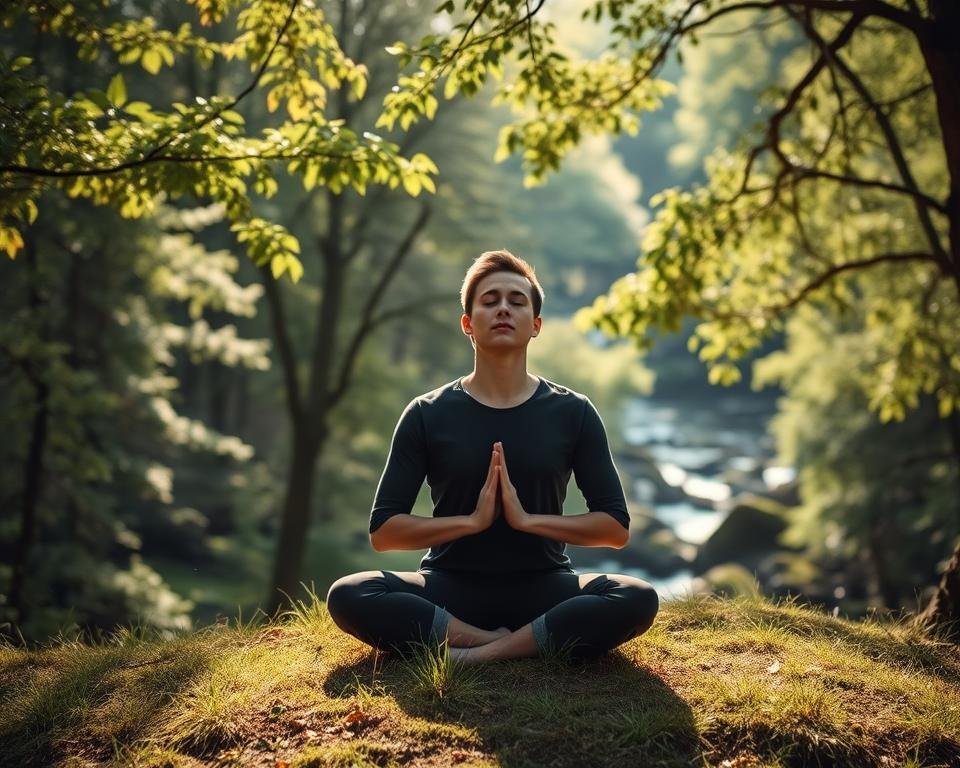I found that adding mindfulness to our daily lives can change us. It makes us stay in the moment and focused. It also lowers stress and boosts our happiness.
As someone who has tried mindfulness for beginners, I know it works well. It makes our minds clearer, helps us control our feelings, and makes life more positive.
Key Takeaways
- Understand the basics of mindfulness and its benefits
- Learn simple techniques to reduce stress and anxiety
- Discover how mindfulness can improve mental clarity and focus
- Explore ways to incorporate mindfulness into daily routines
- Find out how mindfulness can enhance emotional well-being
Understanding Mindfulness: An Introduction
Getting to know mindfulness is the first step to bettering our lives. It’s about being in the now, noticing our thoughts, feelings, and body sensations without judgment.
What is Mindfulness?
Mindfulness means being aware of the present moment. It’s about noticing our experiences, like thoughts, emotions, and body feelings, without getting lost in them. This practice helps us understand ourselves and our world better.
Practicing mindfulness helps me notice my thoughts and feelings more. This makes it easier to handle stress and anxiety. I can think before acting, instead of acting on impulse.
The Benefits of Practicing Mindfulness
Mindfulness offers many benefits. Some key ones are:
- Reduced stress and anxiety: Mindfulness lowers stress hormones like cortisol.
- Improved mental clarity and focus: Regular mindfulness boosts attention and concentration.
- Enhanced emotional regulation: Mindfulness helps us better understand and manage our emotions.
A study on mindfulness benefits is shown in the table below:
| Benefit | Description | Impact |
|---|---|---|
| Reduced Stress | Decreased production of stress hormones | Improved overall well-being |
| Improved Focus | Enhanced mental clarity and concentration | Better performance in work and daily activities |
| Emotional Regulation | Greater awareness and management of emotions | More harmonious relationships and decision-making |
Adding mindfulness to daily life brings these benefits. As I keep practicing, I see a big positive change in my life.
The Science Behind Mindfulness
Exploring the science of mindfulness shows its benefits are well-studied. Mindfulness meditation, in particular, has caught many researchers’ attention.

Mindfulness changes the brain in big ways. It can make areas for attention, emotion, and memory grow. This happens with regular practice.
How Mindfulness Affects the Brain
The brain’s reaction to mindfulness is really interesting. Studies show it can improve attention and memory. It also lowers stress and anxiety by reducing cortisol.
Mindfulness meditation helps the brain’s default mode network. This network is for daydreaming and thinking about ourselves. Mindfulness makes us less caught up in negative thoughts.
Research Supporting Mindfulness Practices
Many studies back up mindfulness’ benefits. For example, a JAMA study found it helps with anxiety and depression. Another study showed it helps with chronic pain.
More research on mindfulness shows it’s good for both mind and body. Adding mindfulness to daily life can improve overall well-being.
Simple Mindfulness Techniques for Beginners
Starting with simple mindfulness techniques can greatly improve your well-being. Mindfulness means being fully present in the moment. It’s easy to start with simple exercises.
Breathing Exercises
Breathing exercises are a great way to begin mindfulness. They help calm your mind and lower stress. Find a quiet spot, sit comfortably, and focus on your breath.
Steps for Breathing Exercises:
- Find a comfortable seated position.
- Close your eyes and take a deep breath in through your nose.
- Hold the breath for a few seconds.
- Slowly exhale through your mouth.
- Repeat for several minutes.
Body Scan Meditation
Body scan meditation focuses on your body, from toes to head. It helps release tension and relaxes you.
How to Practice Body Scan Meditation:
- Lie down or sit comfortably.
- Close your eyes and take a few deep breaths.
- Bring your attention to your toes, noticing any sensations.
- Gradually move your focus up through your body.
- Take your time and breathe deeply.
Mindful Eating
Mindful eating makes you enjoy food more. It’s about noticing the food’s colors, smells, and tastes. Also, pay attention to how it feels to eat.
Tips for Mindful Eating:
| Tip | Description |
|---|---|
| Eat Slowly | Take your time to chew and savor each bite. |
| Notice the Colors | Pay attention to the colors and presentation of your food. |
| Savor the Flavors | Notice the different flavors and textures. |

Adding these simple mindfulness techniques to your day can help. You’ll feel less stressed and more calm.
Advanced Mindfulness Techniques
Exploring mindfulness further, I’ve discovered advanced methods like mindfulness meditation and loving-kindness meditation. These practices can boost your mindfulness routine. They bring a deeper calm and compassion.

Mindfulness Meditation
Mindfulness meditation is a strong technique. It’s about focusing on the present moment without judgment. To start, find a quiet spot, sit comfortably, and close your eyes. Focus on your breath.
When your mind drifts, gently bring it back to your breath. Don’t judge yourself.
Tips for effective mindfulness meditation:
- Start with short sessions (5-10 minutes) and gradually increase the duration.
- Be patient with yourself; it’s normal for the mind to wander.
- Use a guided meditation app if you’re new to meditation.
Loving-Kindness Meditation
Loving-kindness meditation, or Metta meditation, aims to grow love, compassion, and kindness. Start by sitting comfortably, then close your eyes and breathe deeply. Begin by wishing kindness to yourself.
Repeat phrases like “May I be happy, may I be healthy, may I be at peace.”
To expand your loving-kindness meditation practice:
- Gradually include friends and family in your meditation, wishing them well.
- Extend kindness to those you may have difficulty with.
- Lastly, include all beings in your circle of kindness.
Adding these advanced mindfulness techniques to your daily life can deepen your peace and connection. It helps you feel closer to yourself and others.
Mindfulness in Daily Life
Mindfulness is about being fully present in what we do. It helps us feel less stressed and more productive. By adding mindfulness to our daily tasks, we get many benefits.
Incorporating Mindfulness into Routine Activities
Practicing mindfulness is easy. We can do it while eating, walking, or even showering. For instance, when eating, we can enjoy the taste, smell, and feel of our food. This makes eating more enjoyable and keeps us in the moment.
Walking can also become a mindfulness exercise. By noticing our steps, the ground beneath us, and our breath, we can make walking a calming activity.

Practicing Mindfulness at Work
Mindfulness works well at work too. Short breaks to breathe deeply can lower stress. It also makes talking to coworkers better and creates a happier office.
At work, we can take mindful walks, breathe deeply at our desks, or notice our senses. These actions improve our focus and reduce worry.
Adding mindfulness to our work and personal lives increases awareness. It makes life more balanced and fulfilling.
Mindfulness and Stress Reduction
Mindfulness is key for handling life’s tough times. It helps us deal with stress, which affects our health. Mindfulness uses meditation and deep breathing to fight stress.
Living mindfully can really cut down stress. It helps us notice our thoughts and feelings better. This way, we can handle stress better.
Identifying Stress Triggers
First, we need to know what stresses us out. Things like work, money, and personal issues can be big stressors. Mindfulness helps us spot these early and act on them.
- Work-related pressures
- Financial worries
- Personal relationship issues
Knowing what stresses us is the first step to dealing with it. Mindfulness, like meditation, makes us more aware of these triggers.
Mindfulness Strategies for Stress Relief
There are many ways to use mindfulness to reduce stress. Some include:
- Mindfulness meditation
- Deep breathing exercises
- Body scan meditation
Let’s explore how these methods can help us feel less stressed.
| Mindfulness Strategy | Description | Benefits |
|---|---|---|
| Mindfulness Meditation | Focusing on the present moment without judgment | Reduces stress, improves focus |
| Deep Breathing Exercises | Conscious breathing to calm the mind and body | Reduces anxiety, promotes relaxation |
| Body Scan Meditation | Focusing on different parts of the body to release tension | Relaxes the body, reduces physical stress |

Adding these mindfulness strategies to our daily lives can lower stress. I’ve seen how regular mindfulness practice helps manage stress. It also makes me more focused and calm.
Mindfulness in Relationships
Mindfulness is key to healthy relationships. It helps us talk better, feel more for others, and connect deeper.
Being mindful makes us aware of our thoughts and feelings. This awareness helps us think before we act. We talk better and avoid fights caused by not understanding each other.
Communicating Mindfully
Communicating mindfully means being fully there with others. We listen well, without interrupting or judging. This makes a safe space where everyone feels heard and understood.
Some effective mindfulness techniques for better talking include:
- Maintaining eye contact with the other person
- Using open and non-judgmental body language
- Avoiding distractions, such as turning off our phones
Empathy and Mindfulness
Empathy lets us feel and share others’ feelings. Mindfulness makes us more in tune with others’ emotions. This builds stronger, more meaningful bonds.
Adding mindfulness exercises to our day boosts empathy and kindness. This leads to happier, more fulfilling relationships.
Mindfulness for Mental Health
Mindfulness is now seen as a key for better mental health. It helps people deal with anxiety and depression. This leads to a better life quality.
Mindfulness means focusing on the now without judgment. It helps people handle their thoughts and feelings better. This reduces the effects of mental health problems.
Managing Anxiety with Mindfulness
Anxiety is a big mental health problem. Mindfulness, like meditation and deep breathing, can help. It makes people relax and worry less.
Mindfulness techniques for anxiety include:
- Mindful breathing exercises
- Body scan meditation
- Mindful walking
Using Mindfulness for Depression Management
Depression is another big mental health issue. Mindfulness helps people watch their thoughts and feelings without getting too caught up.
A study showed mindfulness helps with depression. People who practiced mindfulness felt less depressed. Here are the study’s results:
| Group | Pre-Mindfulness Depression Score | Post-Mindfulness Depression Score |
|---|---|---|
| Mindfulness Group | 25 | 15 |
| Control Group | 24 | 23 |

In short, mindfulness is great for mental health. It helps with anxiety and depression. Adding mindfulness to daily life can greatly improve mental well-being.
Tools and Apps for Mindfulness
In today’s world, many tools and apps help with mindfulness. They are great for beginners or those wanting to try new things.
Mindfulness apps are very popular. They offer guided meditations, ways to track your progress, and plans just for you.
Popular Mindfulness Apps
Many apps are known for helping people relax and focus. Here are some favorites:
- Headspace: It has personalized meditation sessions and is easy to use.
- Calm: It has guided meditations, sleep stories, and relaxing music.
- Insight Timer: It has lots of free guided meditations and a timer for your practice.
- Meditation Studio: It offers high-quality guided meditations for relaxation and stress relief.
These apps meet different needs and tastes. They help people find a mindfulness practice that fits them.
Additional Resources for Mindfulness
There’s more than apps for mindfulness. Here are some other resources:
| Resource | Description |
|---|---|
| Mindfulness Books | Many books share insights on mindfulness, its theory, and how to use it in daily life. |
| Online Courses | Coursera and Udemy have courses on mindfulness and meditation. |
| Local Mindfulness Groups | Many communities have groups for regular mindfulness practice. |
Checking out these resources can make your mindfulness journey richer. They add variety and depth to your practice.

Overcoming Challenges in Practicing Mindfulness
Practicing mindfulness is rewarding but comes with obstacles. We face challenges when we try to make mindfulness a part of our daily lives. These challenges can test our willpower and dedication.
It’s key to know the common problems faced by those who practice mindfulness. Two big areas of challenge are dealing with distractions and staying committed to the practice.
Dealing with Distractions
Dealing with distractions is a big challenge in mindfulness. Things like phone notifications or our own thoughts can make it hard to focus.
To handle distractions, try these tips:
- Make a special place for mindfulness, away from distractions.
- Use tools like website blockers or apps to stay focused.
- Notice and let go of your own distractions, focusing on your mindfulness practice.
Staying Committed to Your Practice
Staying committed to mindfulness is tough for many. Being consistent is important to see the benefits, but it’s hard with our busy lives.
To keep up, try these methods:
| Strategy | Description |
|---|---|
| Start Small | Start with short mindfulness sessions and slowly make them longer. |
| Schedule It | Make mindfulness a must-do part of your day, schedule it. |
| Find a Community | Join a mindfulness group or find a practice buddy for support and motivation. |
By facing these challenges and using the right strategies, you can grow your mindfulness practice. This will help you enjoy its many benefits.
In conclusion, overcoming mindfulness challenges needs patience, persistence, and the right strategies.
Mindfulness: A Lifelong Journey
Starting a mindfulness journey is exciting. It’s not just about reaching a goal. It’s about making mindfulness a big part of your life. This practice grows with you, making life’s ups and downs easier to handle.
Embracing a Mindful Lifestyle
To keep going on your mindfulness path, set goals you can reach. Think about where you want to use mindfulness, like when you’re stressed or with others. Having clear goals helps you stick to your mindfulness routine.
Nurturing Your Mindfulness Practice
As you move forward, take care of your mindfulness practice. Try different techniques, like meditation or deep breathing, to see what fits you best. Regular practice sharpens your awareness of thoughts, feelings, and the world around you. This leads to a more mindful and happy life.
FAQ
What is the best way to start a mindfulness practice?
Start with simple things like breathing exercises or body scan meditation. Use apps like Headspace or Calm to help you.
How often should I practice mindfulness?
Practice every day, even for just a few minutes. This makes mindfulness a habit and brings benefits.
Can mindfulness help with anxiety and depression?
Yes, it can help manage anxiety and depression. It teaches you to be present and not judge your thoughts. It’s often used with other therapies.
What are some mindfulness techniques for stress relief?
Techniques like deep breathing, progressive muscle relaxation, and mindful walking help reduce stress. They promote relaxation too.
How can I incorporate mindfulness into my daily routine?
Add mindfulness to daily activities like eating, showering, or driving. Focus on your senses and be present.
Are there any mindfulness apps that you recommend?
Yes, Headspace, Calm, and Insight Timer are good. They offer guided meditations and help you track your practice.
Can mindfulness be practiced in a group setting?
Absolutely, group settings can keep you motivated and help you learn from others. Many yoga studios and wellness centers offer classes.
How long does it take to see the benefits of mindfulness?
You can see benefits in days to weeks with regular practice. But, mindfulness is a lifelong journey. The more you practice, the more benefits you’ll get.



